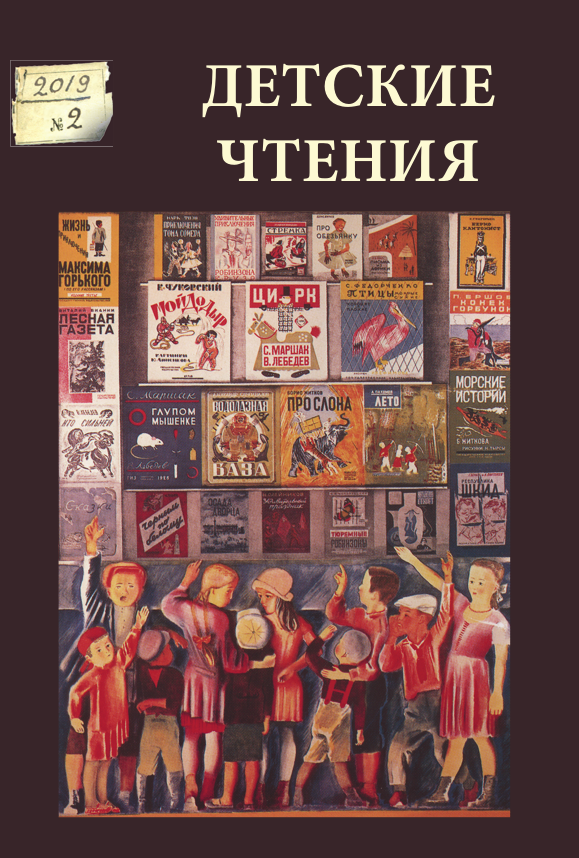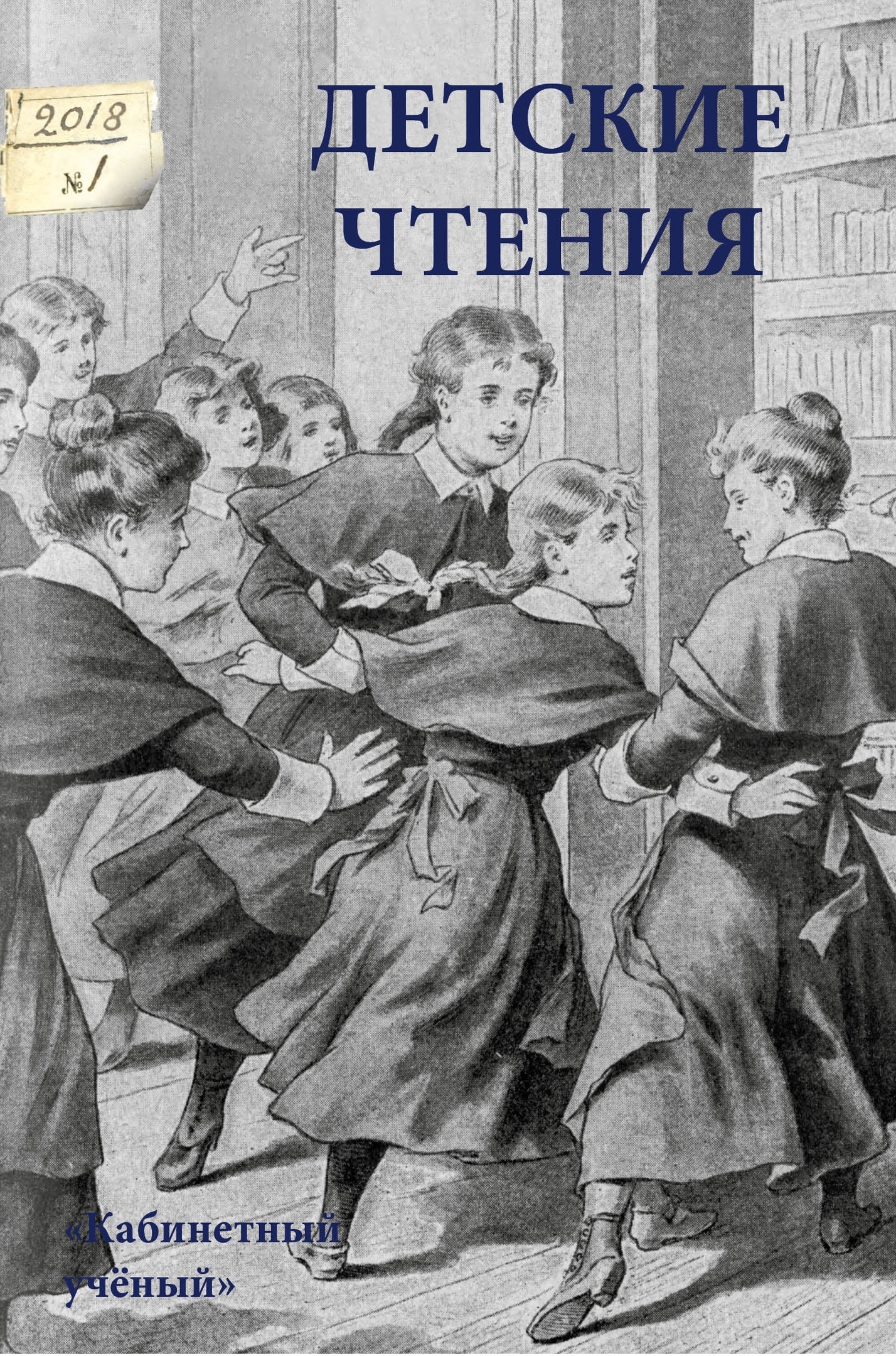Archives - Page 2
-

Vol. 18 No. 2 (2020)
The issue is devoted to the study of poetry for children and its translations. The research focuses on semantics and pragmatics of poetry for children: the development of children's poetry in Russia and Europe, literary criticism, rhythm, and metrics, applied poetry for children, pedagogical discussions that arise around it. Studies of translations of foreign-language poetry for children make it possible to see the similarities and differences in the development of poetic traditions for children in different languages and in different countries, as well as the boundaries of the individual contribution of the translator to the text, which they transplant into a different cultural soil in a different poetic environment.
-

Vol. 17 No. 1 (2020)
Volume 17 is devoted to the discussion of taboos in children's literature. During the Enlightenment, authors of children's books were united in their intention to teach children virtues by showing them “good and bad examples of behavior,” and none of the authors had the idea that any inconvenient, controversial, or provocative theme should be allowed in writing for children. However, already in the second half of the XIX century, critics singled out “harmful topics” that, due to their neglect, leaked into works for children and urged to fight such topics. On the contrary, at the beginning of the 20th century, they demanded to expand the scope of children's literature and introduce “burning topics of social struggle” into it. The Archive section materials are devoted to a retrospective of notions of taboos in children's books and children's reading. XXI century became a time of rapid elimination of taboos that have accumulated over the previous century, reflected in articles included in this issue.
-

Vol. 16 No. 2 (2019)
The 16th issue of Children's Readings is devoted to the research of children's books of the first three decades of the 20th century. During this period, the number of illustrated children's books and magazines increased markedly, cartoons for children started to appear, along with the development of mass education, school visual aids (posters, stands, illustrations in textbooks, etc.) has spread. In most of the articles of the issue, the authors in one way or another turn to the study of the international context of Soviet visual culture addressed to children: the influence of the British school of illustration on the Russian one, the influence of Soviet artists on French illustrators, the influence of American animation on the Soviet one, etc. This issue explores the importance of international exchange in the development of children's visual culture during the period. The visual content of children's books and magazines from the first third of the twentieth century gives a fair understanding of the extent to which borrowings influenced the formation of the image of Russia in other countries, and, on the contrary, how stereotypes about the “West” were reflected in the Soviet book culture for children.
-

Vol. 15 No. 1 (2019)
The 15th of the "Children's Readings" was conceived as an issue devoted to the research of children's literature in the 19th century, the period which significance in the history of children's literature is quite considerable. In this century, the first professional authors writing for children have appeared, the main directions and genres of children's literature developed, institutional structures that ensure the full functioning of literature for children and youth began to form (such as specialized publishing houses, children's magazines, criticism and bibliography of children's literature). However, very few articles and materials related to the stated topic were received by the editorial office. Articles about 19th-century children's literature published in the fifteenth issue of "Children's Readings" composed a very modest contribution to the study of this "dark" age in the history of Russian children's literature. The articles and essays published in the current volume examine various aspects of the history of literary ties and influences, the specifics of national children's works of literature, the issues of translation and adaptation of fiction and educational literature for children, as well as the pedagogical and reader's reception of foreign texts.
-

Vol. 14 No. 2 (2018)
Issue 14 is devoted to the study of academic and publishing commentary on children's literature. “Keys from the inheritance” that modern commentators select for Soviet children's literature, the motives, and pragmatics of using these keys are the main topics of the issue. The widespread opinion that commentary for children is a special kind of commentary designed to explain to children what is incomprehensible in the text (that is, in fact, to interpret the unclear content) has recently been radically revised. Comments are increasingly becoming a way to convey to young readers an adult position on the Soviet (or other) past, eventually turning from a textological commentary into a commentary that sets the normative reading of the text, pedagogical in the broad sense of the word. Another aspect, stated on the pages of the current volume of Children's Readings, is children's literature as a legitimate academic commentary object. The issue includes articles offering examples of just such studies: an academic commentary on the Soviet children's literature.
-

Vol. 13 No. 1 (2018)
The 13th issue of the Children's Readings magazine is dedicated to the memory of the outstanding Russian researcher of the history of children's literature Evgenia Oskarovna Putilova (1923–2018). The preparation of the volume began at the time of the celebration of the 95th anniversary of Evgenia Oskarovna and ended in the days of mourning. Thus, some of the materials for this issue were prepared with the participation of Evgenia Oskarovna herself, and some are a tribute to her memory. The thematic block dedicated to Evgenia Oskarovna Putilova includes articles and materials related to the anniversaries of certain children's writers, children's books, and their characters. In addition, it includes publications that thematically overlap with the sphere of scientific interests of E.O. Putilova. This section opens with interviews with children's writers and researchers of children's literature, telling about the life and work of E.O. Putilova, and a conversation with Evgenia Oskarovna, recorded by the staff of the editorial board of Children's Readings. The Archive section contains a republication of articles by E.O. Putilova about children's writers Alexander Annenskaya, Maria Pozharova, Lydia Charskaya, and Leonid Panteleev.
-

Vol. 12 No. 2 (2017)
The 12th issue of "Children's Readings" is dedicated to the centenary of the 1917 revolution. The studies presented in this issue aim to clarify the significance of the revolutionary events of 1917 in the history of children's literature. The transformation of the content and pragmatism of children's literature in the 1920s was not overnight. New Soviet values began to be articulated only in 1923–1924, when, on the one hand, plots related to leftist ideology, such as “proletarian tales”, began to circulate in Russia more actively. The section "Diary of Kostya Ryabtsev: Three Dimensions" contains materials dedicated to one work, which can be called "exemplary of the era". N. Ognev's story absorbed genre, and stylistic searches of avant-garde art reflected reforms and experiments in school education in the 1920s and became the canonical representation of Soviet Russia in the west. Noted philologists, journalists, translators, and publishers answered the questions of DC's questionnaire. Among the survey participants are Konstantin Polivanov, Elena Romanicheva, Ilya Bernstein, Tatiana Sigalova, and others.
-

Vol. 11 No. 1 (2017)
The 11th issue is devoted to children's reading in/about the widely understood East. Sergei Anikeev and Akifimi Takeda, studying Russian writer-Esperantist Vasily Yakovlevich Eroshenko, who lived in Japan, wrote in Japanese and contributed to the development of children's literature in this country. The translator herself, including children's literature, Lena Baibikova, offered her interview with the translator and Japanese literature publisher. Ludmila Averyanova, Ksenia Golovina, and Anna Savinykh, who live in Japan, shared their thoughts on Japanese books for kids. Olga Simonova wrote an article about creating The Tower of Babel and Other Ancient Legends, a version of the Bible for children, and attempts to publish it in the 1960s in the USSR. A commentary translation of a fragment of the book by Bing Xing, a Chinese writer, one of the founders of modern children's literature, was provided by Natalya Vladimirovna Zakharova. This time, we deliberately did not strictly distinguish between "Research" and "Materials" sections, articles from essays, as we wanted to show the polyphony, diversity of interests, and researchers' topics.
-

Vol. 10 No. 2 (2016)
The 10th-anniversary issue was compiled based on materials from several conferences and seminars dedicated to children's reading. The first section, "Teenage Reading of the Thaw": Publication Stories, Reception, Reputations" was based on the reports presented in the section "Books of Soviet Childhood: History of Creation, History of Reception and Possibilities of Modern Reading" December 2015). The "Archive" section this time presents archival documents discovered by Maria Mayofis and provided with a scientific commentary by Ilya Kukulin. The next section, "History of criticism of children's literature," is composed of articles based on reports presented at the conferences "Education of a new reader (to the 150th anniversary of criticism of children's literature)" (IRLI (Pushkin House) RAS, November 2015) and "Children's literature as event " (Moscow State Pedagogical University, December 2015). The third section, "Literature for Children and Soviet Ideology," is the materials of the reports presented at the permanently functioning research "Children's Seminar" of the IRLI (Pushkin House) RAS. The last block contains studies on contemporary literature.
-

Vol. 9 No. 1 (2016)
Volume Nine of Children’s Readings is dedicated to the studies of Tove Jansson’s narratives about Moomintrolls. The scholarship dedicated to this famous Scandinavian author (1914–2001), who was recognized as a classic for children’s literature of the XXth century, is full of gaps and omissions. A significant amount of responses to her books translated into Russian in pedagogical literature overpowered the study of this author’s aesthetics and her stories’ literary value. Thus, this particular volume is called to present a new phase in this author's scholarship and work. In this volume, scholars are participants of the International Conference, “Philosophical Experience of Children’s Literature: Moomintrolls and Others”, that was organized in celebration of Tove Jansson’s centennial. Those authors represent different branches of the humanities from philosophy to philology and cultural studies, thus demonstrating different approaches to the subject of their research.






